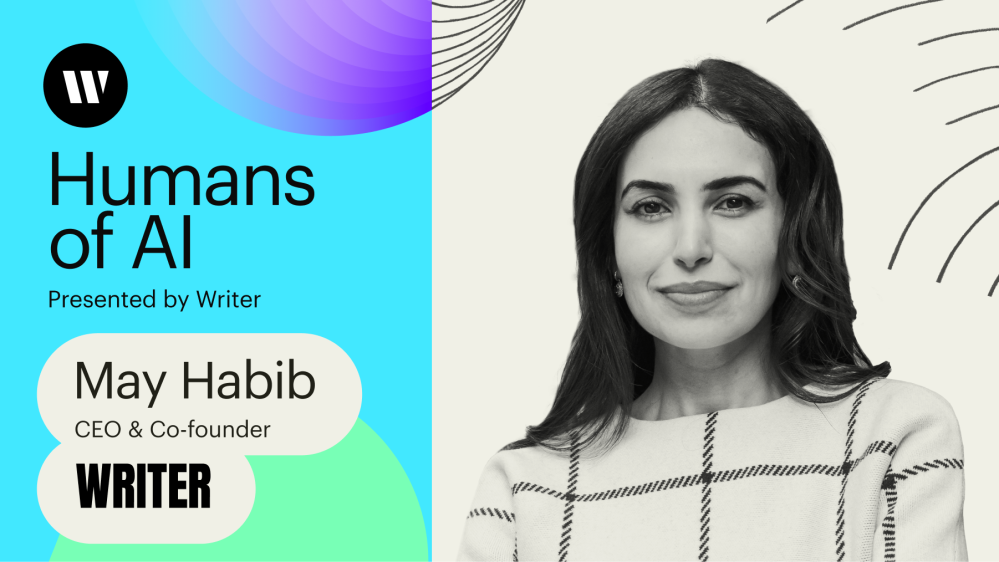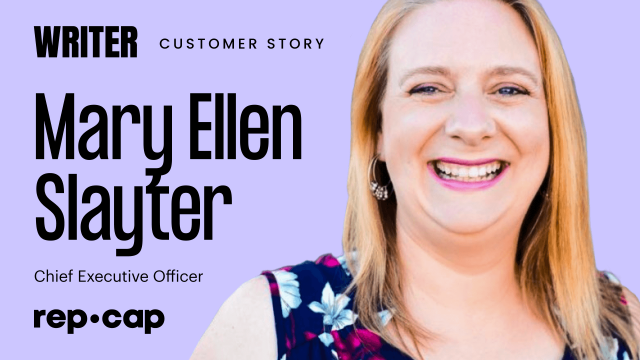Humans in the loop
– 6 min read
Embracing risk and equity: May Habib’s journey into the world of generative AI

Our stories are what make us human. Our stories shape how we see the world, how we see ourselves, and how we impact others. In the age of AI, this simple truth will help light our way as we strive to transform the world around us for the better.
In our first episode of Humans of AI, we bring you a captivating conversation with May Habib, a trailblazer in the tech industry and the CEO and co-founder of WRITER. May’s story is one of resilience, risk-taking, and a deep commitment to equity in the world of artificial intelligence (AI).
We delve into May’s personal background, her experiences as an immigrant, and how these formative moments shaped her approach to risk-taking. We’ll explore her journey into the tech industry and her unique perspective on the transformative power of generative AI for businesses.
May’s insights shed light on the potential of AI to revolutionize work, but also the importance of approaching its development with equity in mind. Join us as we uncover the key takeaways from this thought-provoking conversation, offering a glimpse into the mind of a visionary leader who is shaping the future of AI.
The power of personal experiences and risk-taking in AI
Growing up in an immigrant family, May often found herself navigating unfamiliar territories, which instilled in her a resilience and a knack for taking risks.
“I do think over time I’ve gotten comfortable being uncomfortable, being scared,” May reflects on her journey. Her upbringing forced her to constantly put herself out there, facing uncomfortable situations head-on. It was through these experiences that she developed the courage to embrace risks and seek out discomfort.
May’s family’s journey from Lebanon to Canada played a significant role in shaping her perspective on risk-taking. She deeply appreciates the opportunities she’s had and understands the importance of seizing them.
In the world of generative AI, where businesses are exploring the transformative potential of AI technology, both vendors and customers must be willing to take risks. May emphasizes the need for a shared commitment to pushing boundaries and embracing the unknown. It’s a partnership where both parties understand the inherent risks involved and are willing to navigate them together.
The transformative power of AI and the pursuit of equity
May’s belief in the potential of AI to revolutionize work is rooted in her understanding of its power to enhance productivity. She envisions a future where AI technology can streamline processes, automate mundane tasks, and free up human potential for more creative and meaningful work. “AI has the potential to be a game-changer in terms of how we work and what we can achieve,” May passionately asserts.
But May also recognizes the potential risks and challenges that come with the rapid advancement of AI.
“We could end up with a really dystopian future where most jobs are done by AI employees and folks who already would have been top of the food chain, you know, that much more productive as a result of having all that leverage,” May cautions. It’s a reminder of the responsibility we have to shape AI in a way that promotes equity and inclusivity.
She emphasizes the importance of approaching AI development with equity in mind, as it has the potential to either create or exacerbate existing inequities in society. For May, this issue hits close to home.
“The language you were born speaking shouldn’t impact the kind of life you end up leading,” May reflects on her own experiences with language barriers. This realization led her to gravitate towards natural language processing (NLP) and machine learning (ML), driven by a deep desire to bridge gaps and create a more equitable future.
“I think what’s interesting now is that AI has both the potential and the risk to be ten, maybe a hundred times more equity-creating or equity-exacerbating, depending on how we shape it,” May explains. This recognition underscores the need for a shared commitment to equity and a thoughtful approach to AI development.
Embracing contrarianism: choosing a different path in AI innovation
WRITER’s decision to build their own AI models and platform, even when others suggested leveraging existing models, was a contrarian move. Taking a contrarian approach requires a certain level of conviction and a willingness to question the status quo. May’s journey into the tech industry and her role as a leader in the AI space exemplify this mindset. She reflects, “A lot of what we’ve been doing has felt contrarian. We built our own models even as folks said, ‘Hey, these frontier models are getting more powerful and cheaper, why don’t you just build on them?’ and that has really proven to be what the enterprise needs.” By daring to be different and embracing the power of taking a different path, we can unlock new possibilities and shape a future where AI is not just a tool but a force for positive change.
May Habib’s contrarian approach serves as an inspiration for others in the industry. By charting their own course and challenging established norms, companies like WRITER can create tailored solutions that meet the unique demands of their customers.
Shared risk and trust: nurturing the relationship between generative AI vendors and customers
May emphasizes the unique nature of this relationship, where both parties must be willing to take risks to make the technology work effectively. She states, “Our customers are taking a big risk in partnering with us because the technology is so exciting and what it enables is so breakthrough.” This recognition of shared risk fosters collaboration and mutual understanding.
Trust plays a crucial role in nurturing the relationship between generative AI vendors and customers. May highlights the significance of trust, stating, “So much of the last year has been WRITER in risk-taking mode. I can’t overemphasize how much risk enterprise generative AI leaders take today.” Building trust requires transparency, open communication, and a shared vision for the potential of AI. It’s through this trust that vendors and customers can navigate the uncertainties and challenges that come with implementing generative AI solutions.May’s insights underscore the importance of shared risk and trust in the vendor-customer relationship within the realm of generative AI. By embracing risk-taking and fostering trust, we can pave the way for a future where AI becomes a powerful force for positive change.
Want to hear more stories of people working at the intersection of business and AI? Subscribe to Humans of AI wherever you listen to podcasts.


